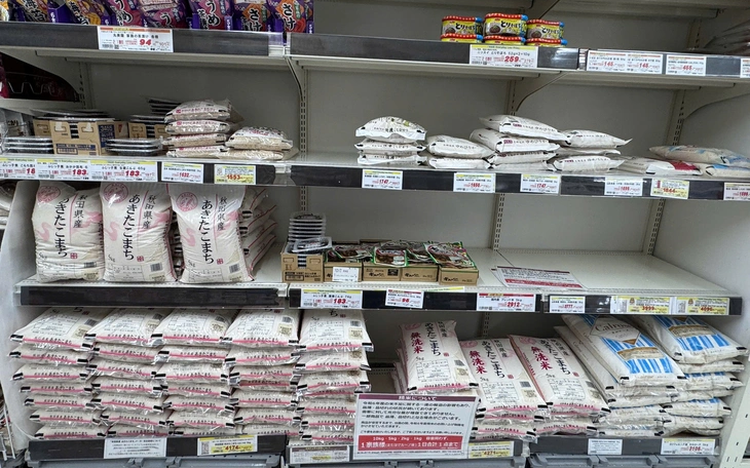
Rice displayed on supermarket shelves in Japan. Photo: Embassy of Vietnam in Japan
Ta Duc Minh, trade counselor at the Vietnam Trade Office in Japan, told Tuoi Tre (Youth) newspaper that he has noticed a shift in Japanese shopping habits during his regular visits to local supermarkets.
More consumers are choosing Vietnamese-made items such as instant pho, vermicelli, and cellophane noodles. The trend has become more noticeable as domestic rice prices in Japan continue to climb.
Even Vietnamese fish sauce, a seasoning once considered too strong for Japanese tastes, is now used in over 50 local restaurants. This development follows a partnership between the Vietnam Trade Office and a Japanese restaurant chain to promote the product.
These examples highlight the potential for Vietnamese agricultural and processed foods in Japan, especially when backed by thoughtful branding and communication strategies.
Since 2024, retail rice prices in Japanese supermarkets have risen sharply. Surveys show that a five-kilogram bag now sells for more than 4,000 yen, or about $28. In this environment, more Japanese retailers and businesses are beginning to explore Vietnamese rice as an alternative.
The Vietnam Trade Office has been promoting Vietnam's ST25 and Japonica rice varieties for two years. However, breaking into the Japanese market remains difficult due to Japan's strict agricultural protection policies.

Ta Duc Minh, Trade Counselor of the Vietnam Trade Office in Japan. Photo: Huu Hanh / Tuoi Tre
Under World Trade Organization commitments, Japan allows duty-free imports of 770,000 metric tons of rice annually. But only about 100,000 metric tons are allocated for private sector use. The remainder goes primarily to food processing or animal feed.
Imports beyond the quota are hit with steep tariffs, currently set at 341 yen, or about $2.4, per kilogram. Vietnam does not benefit from any preferential tariff arrangements under the WTO or the Comprehensive and Progressive Agreement for Trans-Pacific Partnership (CPTPP).
This tariff makes Vietnamese rice less competitive. For instance, importing 10 kilograms of rice outside the quota would incur about 3,410 yen ($23.7) in tax alone, making it difficult for the product to appear on supermarket shelves.
Japan also enforces a complex set of food safety regulations. Rice imports are subject to around 250 baseline criteria, along with additional technical standards. Authorities do not publish lists of banned substances and conduct random inspections. Any violation leads to the shipment being rejected.
Despite these hurdles, there are signs of progress. Vietnamese rice is beginning to draw attention from Japanese importers and retailers. Last month, the Vietnam Trade Office hosted a delegation of Japanese supermarket operators in Vietnam. Several contracts were signed to bring Vietnamese rice to Japan.
Japanese partners have also shown interest in organic rice, particularly Vietnam's ecological farming models such as the rice-shrimp rotation. This resembles Japan's own rice-duck system, where ducks control pests naturally.
Vietnam's produce also appeals to Japanese consumers, who favor fruits like lychee, longan, dragon fruit, mango, banana, and durian. However, these fruits are typically only available during short harvest windows, limiting their market potential.
To expand beyond seasonal exports, Minh has urged Vietnamese companies to invest in post-harvest processing. Dried mango, soft-dried dragon fruit, and bottled lychee juice are among the value-added products that could thrive in Japan.

Posters introducing the dish ‘Vietnamese-style broken rice with grilled pork,’ featuring traditional fish sauce as a main ingredient. Photo: Embassy of Vietnam in Japan
The same logic applies to rice. In addition to raw grains, companies should market processed rice products such as instant noodles, pho, and vermicelli. These items already perform well in the U.S. and Europe but often struggle to enter Japan due to strict controls on additives and preservatives.
To meet Japanese standards, many Vietnamese companies must establish dedicated production lines. Post-harvest preservation, cold storage, and attention to packaging are also essential.
Japanese packaging must clearly list ingredients, allergen warnings, and origin, while also reflecting seasonal themes and holidays like Christmas or cherry blossom season.
Minh also pointed to the 2023 Vietnam Phở Festival in Japan, organized by Tuoi Tre, as a major success in promoting Vietnamese food. Many Japanese attendees who tried pho for the first time later sought out packaged versions in stores.
The festival helped raise awareness not only through flavor, but also through cultural storytelling and brand engagement. This kind of outreach, Minh said, is key to helping Vietnamese products build a lasting presence in Japan.


Max: 1500 characters
There are no comments yet. Be the first to comment.